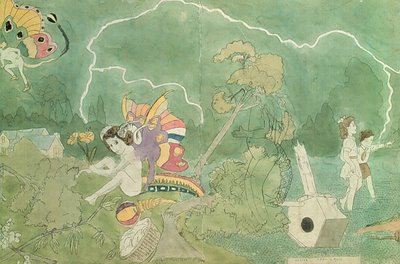About Henry Darger
Henry Darger's landlords, the Lerners, discovered paintings in his apartment: hundreds of brilliant watercolors, some over 3m. long. The images were disturbing and mysteriously beautiful; little girls frolicking under stormy skies, little girls fighting soldiers, little girls being rescued by fantastic winged creatures.
The landlords soon found the other half of Darger’s life’s work, perhaps the longest novel ever written: the more than 15,000 page, single-spaced typed: In the Realms of the Unreal. An epic story of the virtuous Vivian girls and their religious war against the evil Glandelinian army.
His work contains many religious themes, albeit handled extremely idiosyncratically. Darger's human figures were rendered largely by tracing, collage, or photo-enlargement from popular magazines and children's books. Some of his favorite figures were the Coppertone Girl and Little Annie Rooney. The images of daring escapes, mighty battles and painful torture are reminiscent of events in Catholic history; the text makes it clear that the child victims are heroic martyrs like the early saints. One idiosyncratic feature of his artwork is an peculiar transgenderism: characters are often portrayed unclothed or partially clothed, and regardless of ostensible gender, some females have male sex organs. Some feel Darger was unfamiliar with female anatomy, that he meant it as a symbol of power or that he modeled the girls after images of the infant Jesus.
Much of the fascination with Darger concerns his portrayal of horrific brutality against children. For some reason, it is often assumed that Darger wrote and drew this way because he was enacting repressed subconscious desires. A biographer -MacGregor- claims without evidence, that Darger may have killed a girl (Paroubek), and that even if he haven't committed a crime, he "had the mind of a serial killer". It is just as likely that Darger, an abused child who had also witnessed the abuse of others, sought to reveal a truth which polite society did not wish to acknowledge.
Darger wrote also The History of My Life, a book that spends 206 pages detailing his early life before veering off into 4,672 pages of fiction about a huge twister called "Sweetie Pie," probably based on his experience at Countrybrown. He also kept a diary to chronicle the weather and his daily activities.
The sequel to Vivian Girls is called Crazy House: Further Adventures in Chicago. Begun in 1939, it is a Stephen King-like tale of a house which is possessed by demons, haunted by ghosts, or perhaps has an evil consciousness of its own, like the hotel in The Shining. Children disappear into the house and are later found brutally murdered. The Vivians and a male friend are sent to investigate and discover that the murders are the work of evil ghosts. The girls go about exorcising each room until the house is clean.
The Story of the Vivian Girls
or a 15,143-page fantasy manuscript called "The Story of the Vivian Girls, in What is known as the Realms of the Unreal, of the Glandeco-Angelinnian War Storm, Caused by the Child Slave Rebellion"
The Story of the Vivian Girls postulates a large planet around which Earth orbits as a moon and where most people are Christian. The majority of the story concerns the adventures of the daughters of Robert Vivian, seven sisters who are princesses of the Christian nation of Abbiennia, who assist a daring rebellion against a regime of child slavery imposed by the "Glandelinians". The latter resemble Confederate soldiers from the American Civil War. The children take up arms in their own defense and are often slain in battle, or after vicious torture by the Glandelinian overlords. The elaborate mythology also includes a species called the "Blengigomeneans" (Blengins), winged beings with curved horns, who are usually benevolent toward the Vivian Girls.
Through their sufferings, the Vivian Girls are to be able to bring about a triumph of Christianity. Darger provided two endings to the story: in one, the Vivian Girls and Christianity are triumphant; in the other, they are defeated and the godless Glandelinians reign.
http://www.acer-access.com/~darger@acer-access.com
http://dir.salon.com/story/books/review/2002/07/23/darger/index.html
http://dir.salon.com/story/books/review/2002/07/23/darger/index.html


No comments:
Post a Comment